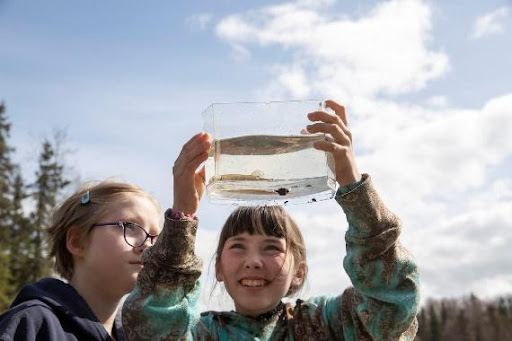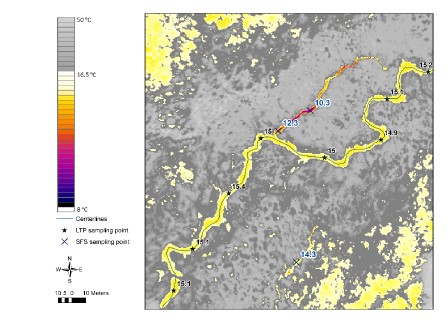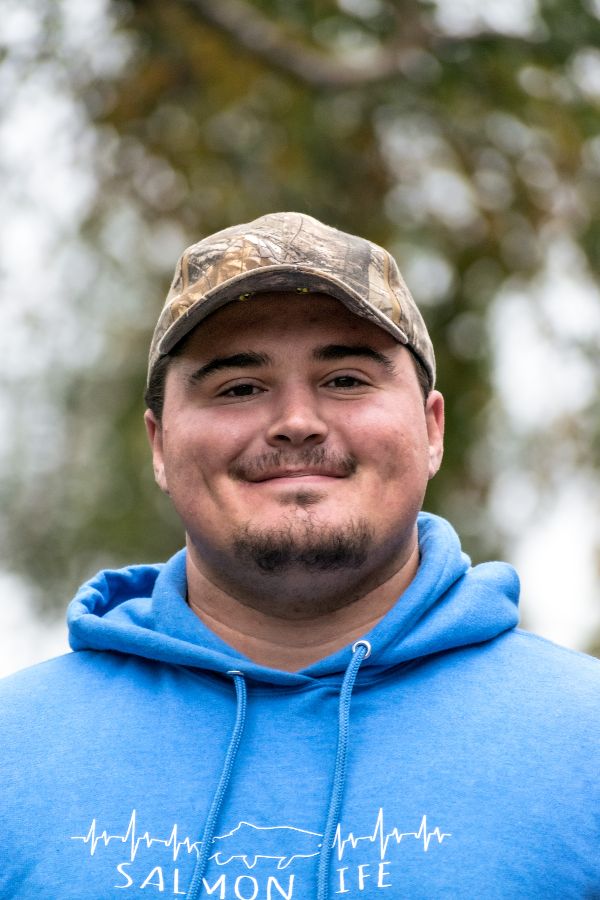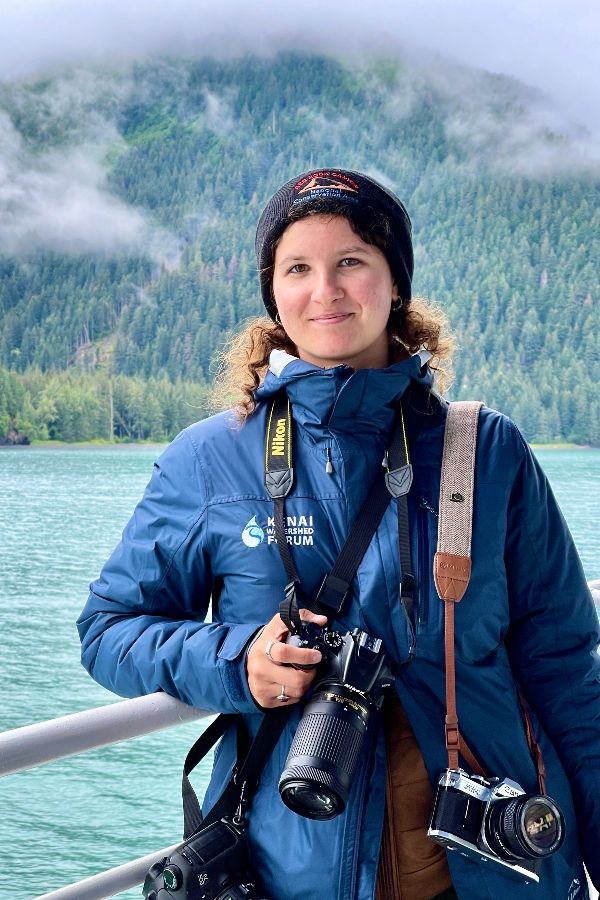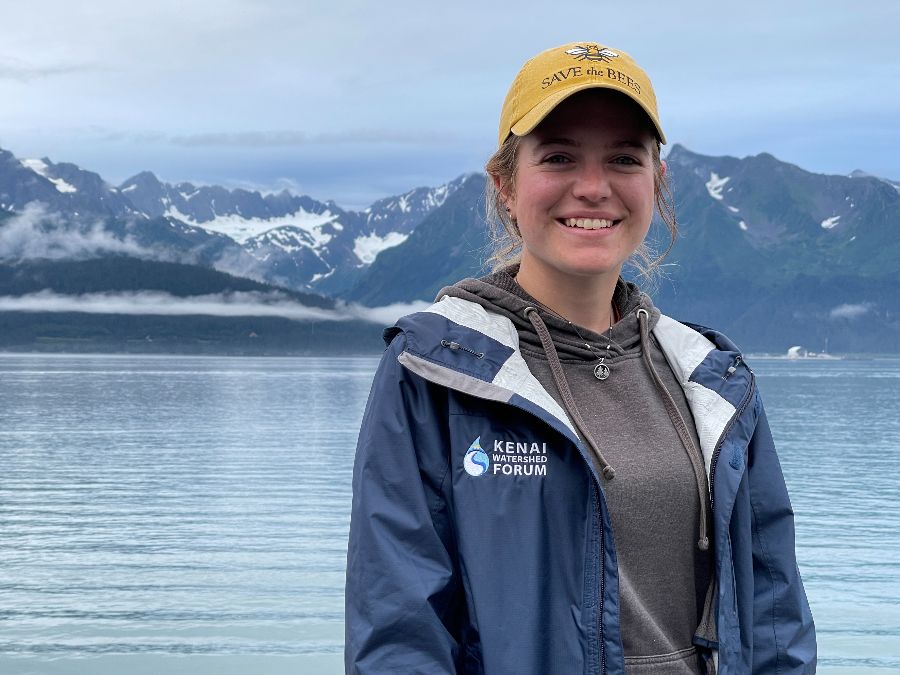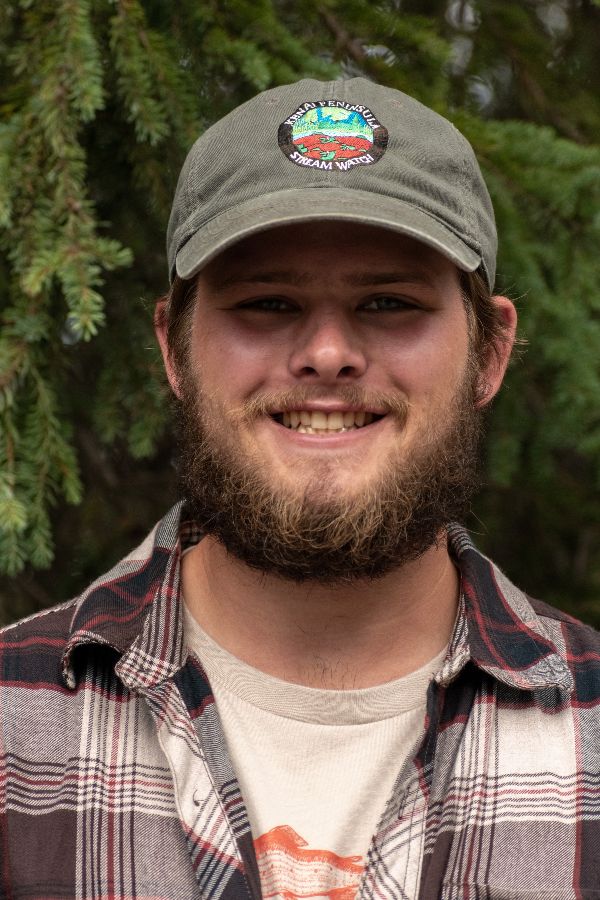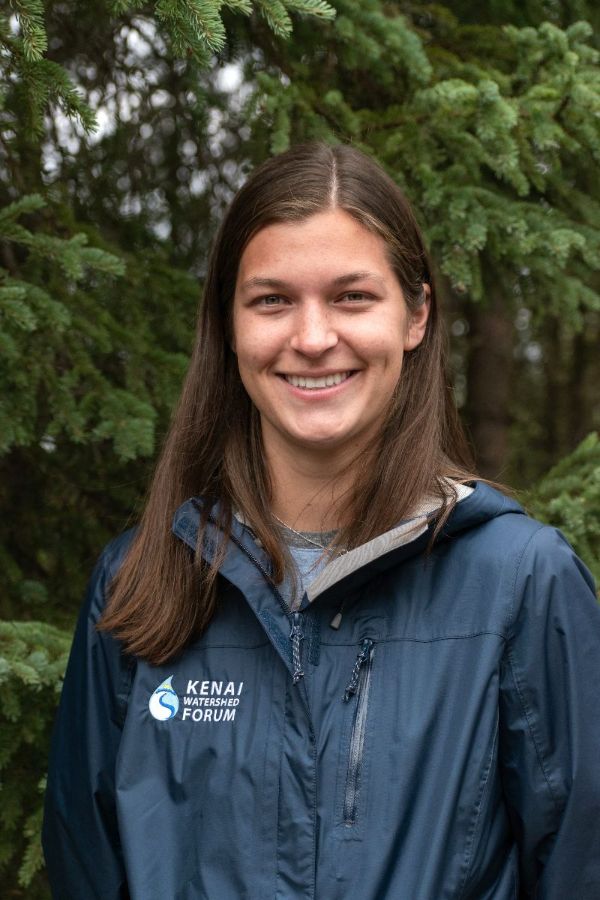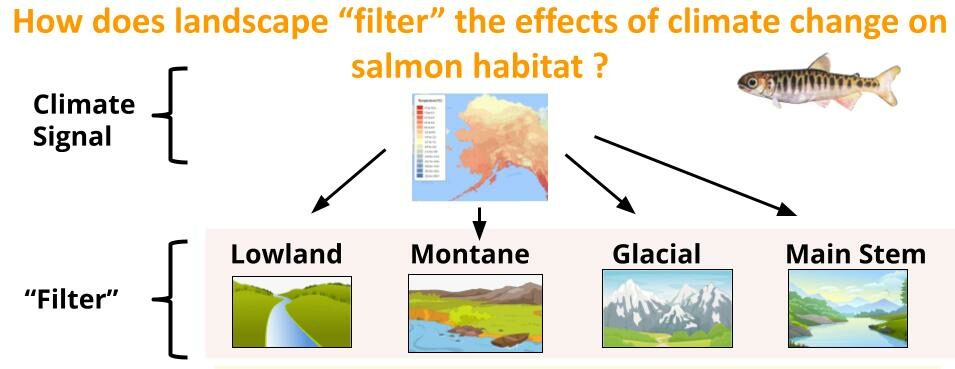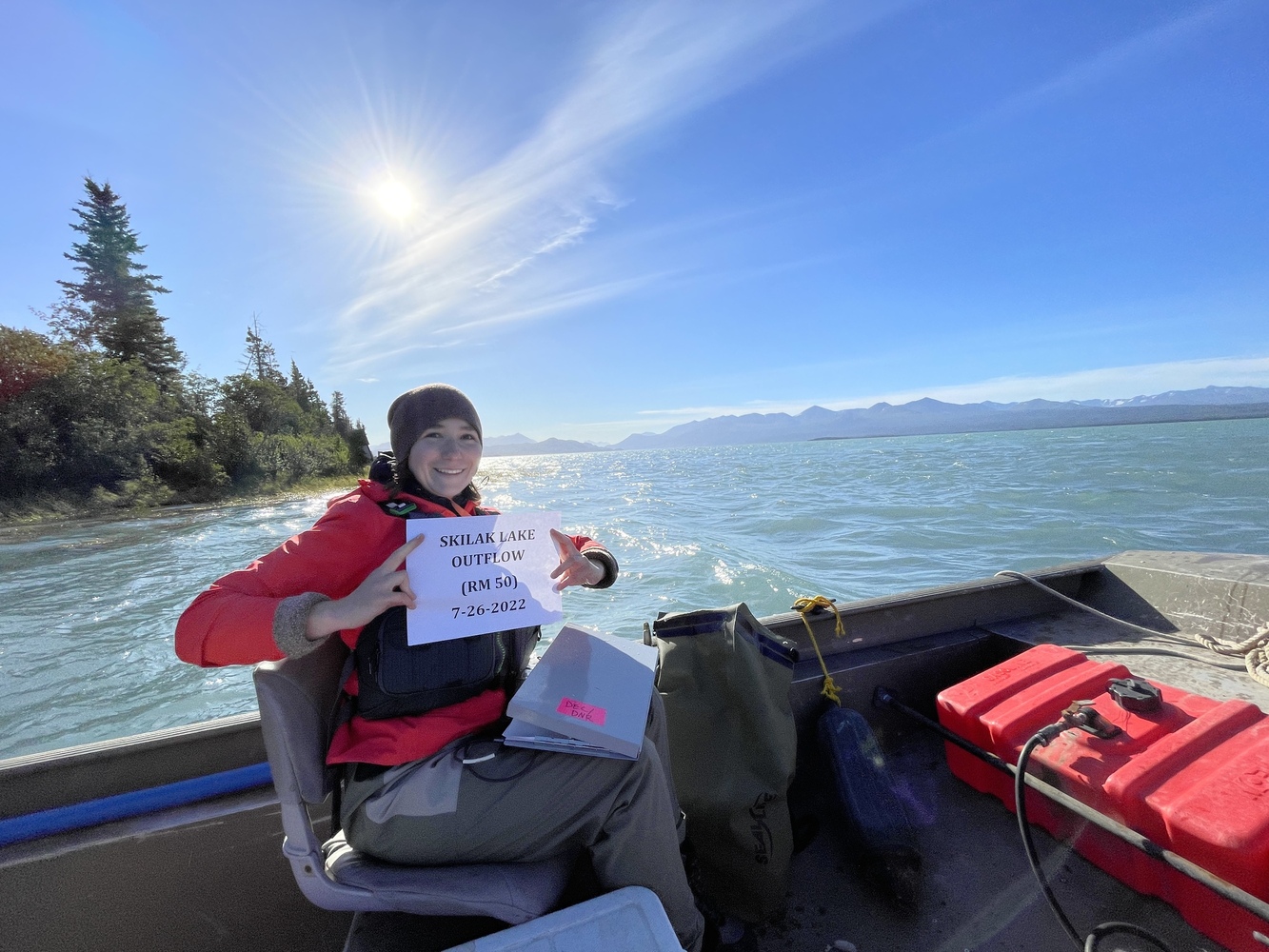Mapping Alaska’s Salmon Streams
February 20, 2023Why map Alaska’s salmon streams?
Since 2012, Kenai Watershed Forum has worked to document Alaska’s salmon streams, lakes, and rivers. This work results in additional habitat registered in the Alaska Department of Fish and Game’s Anadromous Waters Catalog (AWC), the state’s inventory of documented salmon habitat. A thorough inventory of these water bodies is important because it specifies which streams, rivers and lakes are important to anadromous fish species and therefore afforded protection under state and local law. Water bodies that are not “specified” within the catalog are not afforded that protection.
To read more on the why and how of mapping Alaska’s salmon streams, download The challenge of mapping Alaska’s salmon streams here.
Using better maps to make better maps
The work of documenting new salmon streams is little like prospecting for gems. We may have some idea where to look, but we don’t know for certain what we’ll find until we go there. To make best use of time and resources looking for undocumented salmon habitat, we can use sophisticated mapping techniques to help us choose where to go.
There is an evolving set of ideas on how best to use GIS-based mapping approaches to search for undocumented salmon habitat. To help make sense of these ideas and methods, I’ve written up a description some of the different ways that researchers in Alaska have tackled this topic over the last 15 years, and consider what are our best options moving forward. This essay is intended for a more technical audience.
To read more on current and future methods for using maps to help located Alaska’s undocumented salmon streams, download Using better maps to make better maps for Alaska’s salmon streams here.
***
I’ve shared these two essays in particular because I hope to get feedback from all those of you who also work to seek out and document Alaska’s salmon streams. I’d like to hear your ideas, edits, and critiques. I am in the process of understanding the best way to advance this work for our region, and I look forward to doing the work with all of you. Please reach out at ben@kenaiwatershed.org .
– Benjamin Meyer
From Thermal Infrared Maps to Conservation Action
January 26, 2023Example above of airborne thermal infrared imagery showing temperature contrast in a stream. A cold water inflow (purple and blue colors) enters the main channel (yellow color). Figure from NV5 Geospatial.
Cold water refugia, or areas within a stream that are persistently colder than surrounding areas, are critical features of wild salmon habitat throughout their range. Stream reaches with cold seeps and springs often result in much cooler water, which are increasingly important for wild salmon to keep cool as water temperatures in many streams have warmed. Some human activities can diminish or extinguish cold water refugia, such as groundwater withdrawal and construction of impervious surfaces. To conserve cold water refugia these sites must first be mapped and identified, and land owners and managers must understand best practices for their conservation.
Since 2020, three community-based organizations – Cook Inletkeeper, Kachemak Heritage Land Trust, and Kenai Watershed Forum – have worked together to identify where cold water refugia are found in the Kenai Peninsula lowlands, a region where productive wild salmon habitat intersects with a growing development footprint. We used cutting-edge methods to locate cold water refugia with thermal infrared imagery, a technology similar to night vision goggles that shows heat contrast. Our resulting “treasure map” of cold water refugia locations is a valuable tool for prioritizing conservation and outreach efforts.
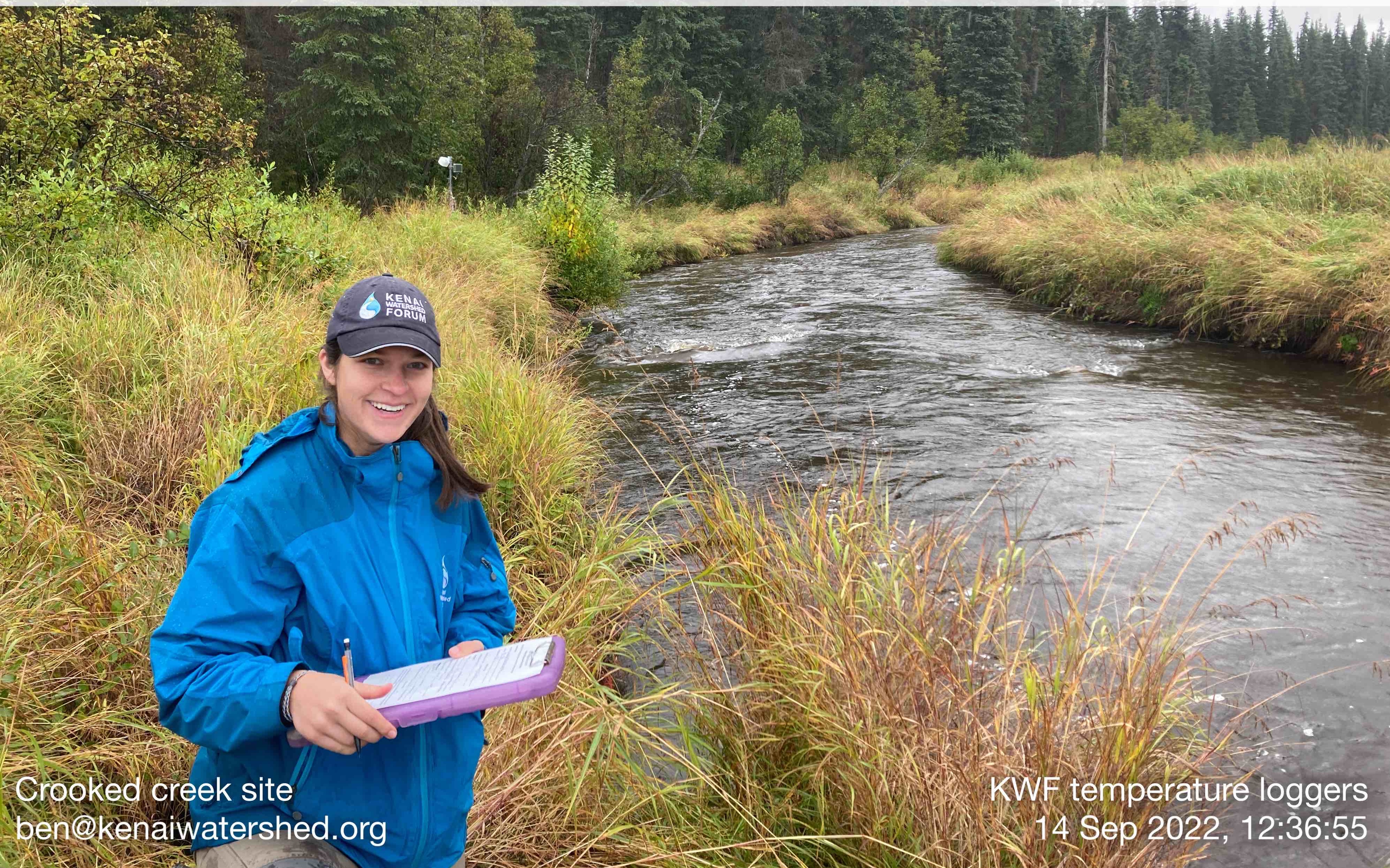
Derrick Via (Summer 2022)
January 4, 2023How do I sum up the Kenai Watershed Forum? A group of cooperative individuals who are motivated to work together amongst each other and with the community for the betterment of all the Kenai Peninsula. It is incredibly encouraging to see so many different agencies and members of the public all working together with KWF. I was often left with a feeling of hope and accomplishment after our days with the public, seeing the passion that our volunteers have. All were full of a drive to learn, make a difference and protect the rivers and lands they call home.
Kenai Watershed Forum was a welcoming and productive work environment, offering me a once in a lifetime intern experience. Most of the summer my coworkers and I would only see each other in passing as there is always much fieldwork to be done, but I always knew that if I ever needed advice or help it was there. There were many long days in the field as the invasive species intern, but I was always eager for the next. Surveying, spraying, cutting seed heads, and pulling invasives were all great times spent with passionate professionals and the public.
One memory that will stick with me forever is going to do an Elodea survey at King Lake. Elodea is a highly invasive aquatic plant likely to be spread to remote lakes primarily by float planes. My co-worker Nathan and I went out on a float plane with around 70lbs of gear each and were dropped off in a massive bog in the rain. Before the plane even left, we realized we were surrounded by bear scat and other signs of bear activity. We kept our bear-spray close as we began to hike to the highest ground we could find. Each step went deeper into the squishy, soaked vegetation more than it went forward. Finally finding a spot higher than the swamp surrounding us, we set up camp in the rain. All things said, once we made a fire it was rather cozy in the wilderness. We ate a hearty dinner in the field by the fire. That evening, we took advantage of the amazing location and went fishing. After cleaning trout slime from ourselves to prevent any bear issues, we warmed up once more by the fire before getting some much-needed sleep.
The next morning, we re-lit the fire and had a hot breakfast to knock the night’s cold from our bones. We packed up camp and once again began the most arduous ¾-mile hike of my life. We put all our gear in our pick-up location and began our survey. We spent hours paddling through nature so gorgeous it felt it shouldn’t be real. Identifying vegetation, thankfully all of which was native, and observing the wildlife made the survey not even feel like work. As we reached the point in which we had to begin our paddle back to the pick-up location, the wind had completely shifted, and the overcast sky opened with a torrential downpour. We paddled for nearly an hour before our plane, which arrived an hour early, made splashdown. The pilot picked us up and explained that two rainstorms were about to converge over us as we taxied to our gear. After grabbing our things and making the flight back to Kenai, we unloaded. We were soaked and tired but had smiles on our faces as we waited to be picked up by a coworker. My partner and I looked at each other and agreed we would do it all over again in a heartbeat!
I have to say thank you to KWF for the incredible memories and experiences I have gleaned from my time there!
Ana Maria Oliynyk (Summer 2022)
January 4, 2023I have had the honor of coming to work with KWF this summer through a fully funded opportunity with the Jeannette K. Watson Fellowship, and in doing so, have had the opportunity to live a wildly unimaginable version of my dreams.
Everything I do revolves around the desire to be in, work with, advocate for, and preserve Nature, and unite people in conservation efforts. In the past few years I have been diving deep into using visual storytelling as a tool to move these efforts forward. It was my greatest hope for this summer that I might be able to apply my work in multimedia to a meaningful internship experience with an environmental organization whose values would align with mine. Finding KWF purely by fate in my search for such a match was the best that could have happened. Not only did I get to immerse myself in the gift of an Alaskan summer, but I have been continuously fulfilled by the opportunity to contribute to KWF’s work with Stream Watch, Invasives, Water Quality, community outreach and more. It has been tremendously impactful to experience such a variety of environmental work; I have been able to go out into the field in the swamps with my camera, meet dedicated members of KWF volunteer community, design graphics for distribution and public education, and collect both written and visual stories to highlight KWF’s unfaltering efforts to preserve and protect the health of the waters of the Kenai Peninsula.
I am eternally grateful for my time at the Kenai Watershed Forum, and for KWF being such an incredible example of what working together for betterment of the environment should look like. Within KWF I have found a flourishing spirit of community, a true reverence for the landscape, wildlife, and people, and a persevering attitude of inclusion that strives to unite all with the common goal of protecting the health of the Kenai Peninsula’s waters and resources. The genuine appreciation of the natural landscape and its resources that Alaskans and the KWF hold is greatly inspiring, and I am excited to take that perspective with me and apply it to my future work. Thank you, KWF, for this once in a lifetime opportunity dream come true!
Alexis McDonald (Summer 2022)
January 4, 2023My internship began when the Russian River ferns were no more than six inches tall. I watched as these plants sprouted taller each week till eventually, they stood taller than me. Being only five two it doesn’t take much to be taller than me but even so, their growth was drastic! In three short months I also witnessed the growth of many other things: baby moose, water levels in the Kenai River, number of salmon fillets in my freezer, and most notably myself.
This summer I moved across the country to join KWF’s team as a Stream Watch intern. I couldn’t have been more excited to get started but still I was nervous to be living in an entirely new environment. As I met the KWF staff my concerns began to dissipate. I received the warmest of welcomes from each and every one of them. They made me feel at home and comfortable in my new surroundings. Throughout the entire summer I received endless support and plenty of guidance from them all. In this environment that they had created, I myself was able to grow in many aspects, except vertically. I gained the much-needed job experience specific to my field of study. My knowledge in conservation, public education, even invasives and hydrology were expanded upon in this time too. Most important to me was my growth in confidence and the formation of amazing new friendships. I truly loved every minute of my time in Alaska and I cannot thank KWF enough for the opportunities and memories.
Kevin Duffie (Summer 2022)
January 4, 2023When I was first hired as a Stream Watch Intern, I had no idea what the title meant or how to explain to my family what I was moving to Alaska to do. I knew that the work was centered on river health and that was enough for me. Everyone chooses internships for their own reasons, and my goal was to experience as much as I could in terms of wildlife, culture, and career interests.
KWF was and continues to be a great place for me to grow as a professional. Within our organization, we have teams involved in invasive species, hydrology, education, and river restoration. This allowed me to spend time within each, and gifted me the opportunity to find out what I am passionate about. I found true joy in sharing my knowledge with others and helping people experience everything this beautiful state has to offer. Without this internship I would not have been exposed to as many environmentally based career paths or been able to network with outdoor professionals on a daily basis.
My final words — beware, those who say you may fall in love with the place and never leave. I came here with a one way plane ticket, and I’m staying until they kick me out!
Sara Aamodt (Summer 2022)
January 4, 2023Coming to the Kenai Watershed Forum, I knew I was going to love it. When I moved to Alaska, I wanted to work outside every day and make a positive impact; KWF was exactly what I was looking for.
I was thrown into the Kenai River Festival during my first week here, and there couldn’t have been a better way to start. During this event, I got to interact with people in the community and see how much they appreciate what our organization does. Even if people don’t know what our current projects are, they understand that we are here to protect and support the environment and resources that locals and tourists enjoy every day.
Additionally, I’ve had the opportunity to work with the kids at summer camp this year. It’s awesome to see how each of the children experiences Alaska and its environment differently. Some kids are way more excited than others, but they all love living here. Summer Camp Director Meg Pike and I got to do everything from teaching kids about macroinvertebrates and water chemistry testing, to seeing bears and baby salmon in the creek on our hike. Every kid was fascinated by something different, and it was inspiring to know that KWF offers such fulfilling experiences to local children.
Through both of these experiences and my work here this summer, I am getting to see the influence that KWF has in the community. We get to show adults and kids alike the importance of Alaskan resources, and renew their appreciation for the local environment.
~ Sara appreciated her time with KWF so much that she is staying on board as full-time staff following her internship ~
New Journal Article by KWF Staff: Climate Change and Juvenile Salmon in the Kenai River
December 6, 2022A new publication authored by KWF Water Quality Coordinator Benjamin Meyer was recently published in the journal Transactions of the American Fisheries Society. Prior to being at Kenai Watershed Forum, Ben was working on his graduate research through University of Alaska Fairbanks with work focused on the Kenai River.
The research began with the broad quandry, “What could climate change mean for juvenile salmon in the Kenai River?” Through time, the question grew narrower and more detailed: since juvenile salmon live in very different habitats throughout the Kenai River, from high, rushing glacial rivers to low, meandering wetland streams, how could climate change affect these populations differently?
For two summers Ben and other researchers captured and measured thousands of juvenile salmon from Beaver Creek to Ptarmigan Creek and everywhere in between. Along with size and weight data they also collected diet contents, scales, water temperature data, and other information. The data was used to model how juvenile fish growth rates could change under future climate conditions.
So what did we learn?
The results suggest that as water temperatures warm over the next century, baby king and silver salmon fry that live in low-elevation tributaries like Beaver Creek are likely to see decreases in summer growth rates. However, for salmon with lots of food in their bellies, warmer waters may not affect their growth rate as dramatically.
Science can often leave us with more questions than answers. Here, we hope that research like this can continue to inform and guide the priorities for conservation restoration in our region.
To read this article, follow the link below. A sincere thank you to all the fellow researchers, co-workers, and community members who contributed their time, sweat, and expertise to make this research happen.
New 2022 Freshwater Conservation Action Plan
November 18, 2022In January 2022, we convened a team of 18 experts in fish habitat and conservation to develop a Conservation Action Plan for the Kenai Peninsula Fish Habitat Partnership. The plan outlines detailed strategies, threats, and recommended actions for freshwater fish habitat conservation in our region. The plan represents the thinking of many of the most cutting edge ecological researchers and managers working in the Kenai region, and will be a valuable tool for anyone planning work here.
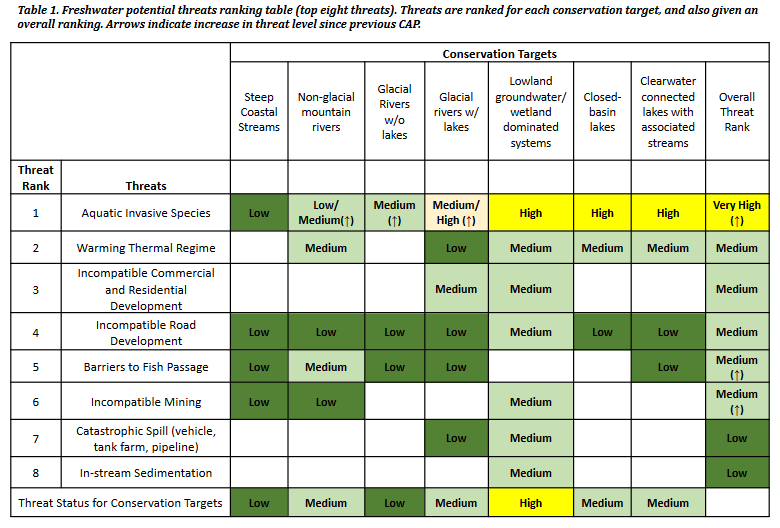
In the above table (Figure 1), we summarized our consensus on which threats are most pressing in different types of freshwater aquatic systems.
To read on, find the 2022 plan along with the supplemental climate change document at https://www.kenaifishpartnership.org/cap/
Access the interactive Partnership area map at bit.ly/kpfhp_map, which includes details about each watershed within the Kenai Peninsula Borough.
We look forward to seeing where this plan takes us in the next ten years!
Summer 2022 Water Quality Sampling Results Available
October 18, 2022Kenai Watershed Forum has received all laboratory results from it’s Summer 2022 Baseline Water Quality Monitoring. The results are currently being prepared for upload to the Environmental Protection Agency’s Water Quality Exchange, a pubic data repository for water quality data. The results have not yet been analyzed to check against water quality standards; we expect to complete this by Summer 2023.
We worked with three laboratories in Summer 2022:
1.) Soldotna Wastewater Treatment Plant – SWWTP provided analyses of Total Suspended Solids:
Download Summer 2022 Total Suspended Solids results
2.) Tauriainen Engineering and Testing – Tauriainen provided analyses of Fecal Coliform
Download Summer 2022 Fecal Coliform results
3.) SGS Laboratories, Anchorage – SGS provided analyses of all other substances monitored in Spring 2022, including nutrients like phosphorus and nitrogen, and metals like zinc, copper, lead, and others:
Download Summer 2022 Metals and Nutrients results
For questions about Summer 2022 water quality results, contact Benjamin Meyer, Water Quality Coordinator. Thank you again to all the participants and volunteers who made this event happen!
